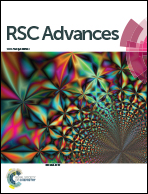Friedel–Crafts reaction of indoles with vicinal tricarbonyl compounds generated in situ from 1,3-dicarbonyl compounds and TEMPO: highly selective synthesis of tertiary alcohols†
Abstract
A novel Friedel–Crafts reaction of indoles with vicinal tricarbonyl compounds generated in situ from 1,3-dicarbonyl compounds, which produces indole substituted tertiary alcohols in good to excellent yields and with good functional group tolerance, has been developed. The mechanistic pathway for this process involves the initial disproportionation of TEMPO, α-oxyamination of the 1,3-dicarbonyl compound followed by N–O bond cleavage to form the tricarbonyl intermediate. Addition of indole to this intermediate then generates the tertiary alcohol product. This method can also be used for the synthesis of pyrrole-containing tertiary alcohols. Further efforts aimed at elucidating the mechanism of the reaction and boardening the substrate scope of this process are ongoing.


 Please wait while we load your content...
Please wait while we load your content...